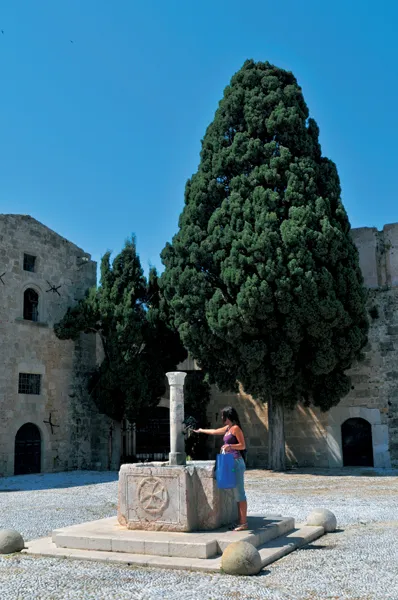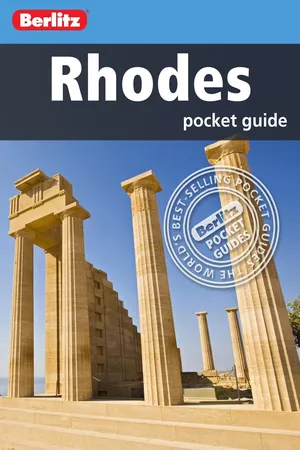Rhodes is an easy island to explore, with a good road network and public transport for independent sightseeing. The old quarters of Rhodes Town (Ródos) 1 [map] and Líndos are mostly car-free, and make ideal places to wander through on foot. There are also numerous tour companies for those who want an organised itinerary.
The view along the east coast from Tsambíka Monastery
Britta Jaschinski/Apa Publications
This guide is divided into several sections, exploring Rhodes Old and New Town first. Then there’s a tour of the eastern coast, with a separate section for the ancient settlement of Lindos and the area south of it, followed by another section covering the western side of the island.
Rhodes Old Town
Nothing quite prepares you for the spectacle of Rhodes Old Town, especially seen from an approaching boat. An immense citadel with high sandstone walls 4km (2.5 miles) around, facing the town’s three natural harbours, it has survived various sieges and bombardments, plus the visibly corrosive effects of damp sea air.
Built on the site of ancient Rhodes, itself founded some four centuries prior to the birth of Christ, the Old Town served from 1309 onwards as the headquarters of the Knights Hospitaller of St John, one of the most powerful of the Christian military orders. Originally established to provide medical care for pilgrims on their journeys to the Holy Land, they soon became one of the leading military opponents of Islam, harrying both Arab and Kurdish armies and later the Ottoman Empire.
In December 1522, after a long siege, Ottoman forces wrested Rhodes from the grasp of the crusader-knights and inaugurated nearly four centuries of Muslim Turkish rule. Vestiges of their influence are still obvious within the walls. The turn of the 20th century saw accelerated Ottoman decline and, in 1912, following the Italian-Turkish War, the Dodecanese islands (including Rhodes) were occupied by Italy. In contrast to Ottoman neglect, the Italians invested considerable effort and money in the Isole Italiane d’Egeo, as they styled this cherished Mediterranean colony.
Victorious Ottoman Sultan Süleyman entered the town through the southwesterly Ágios Athanásios Gate in 1523 and ordered it sealed up thereafter; it was only reopened by the Italians. The gate is, however, now universally referred to as ‘Ágios Frangískos’ after the Italian-built Catholic church just outside.
In the northernmost sector of the Old Town is the Knights’ Quarter or Collachium (kollákio in Greek), where each langue – each nationality within the order – had its inn and the Grand Master had his palace. Beyond this is the Boúrgo or civilian area, where you will find a fascinating maze of streets, comprising the former Turkish and Jewish sectors of the town.
The Walls and Gates
The first impressive feature of the town is the walls themselves. Dating mostly from preparations for the 1480 siege, they sit strong and proud, especially beautiful at dawn, rosy-hued in the sun’s first rays, or at night, lit by the soft glow of wrought-iron lamps. The Knights did not begin the citadel from scratch; they elaborated a series of relatively modest Byzantine defences, creating eight sections of curtain walls, each one the responsibility of a separate langue.
Entering the Old Town through D’Amboise Gate
Britta Jaschinski/Apa Publications
At one time each curtain had a gate; today there are 12 gates in use, each uniquely designed. Many are only wide enough to accept pedestrians or scooters. The most interesting is the D’ Amboise Gate A [map]: situated in the northwest corner near the Palace of the Grand Masters, it was built in 1512, during the reign of Grand Master Emery d’Amboise. It curves in an S-shape to outwit attackers and is then followed by a second gate, Ágios Andónios (St Anthony’s), which lies between two curtain walls.
Beside this gate is one of four discreetly signed entry tunnel-stairways leading to the dry moat B [map], attractively landscaped on the west and southeast sides. You can follow a path in the moat from here all the way around the landward walls to the Akándia Gate on the east side of the city. The walk takes about 30 minutes. However, it is not possible to gain direct access to many of the gates on this route as they sit high in the walls above, with bridges over the moat linking the Old Town to the outside world.
Platía Argyrokástrou
Britta Jaschinski/Apa Publications
On the eastern side of the fortifications, facing Kolóna Harbour, is the impressive Marine Gate, plus in the northeast, linking Kolóna and Mandráki harbours, the smaller Ágios Pávlos (St Paul’s) Gate. In 1924 the Italians decided that traffic would need access along the waterfront. They altered the walls, creating widened entrances for automobiles on the shore between Mandráki and Kolóna ports. The most important of these, Freedom Gate (Pýli Eleftherías) is located just west of St Paul’s Gate, isolating it and the now-vestigial Naillac Tower from the rest of the citadel. Today many visitors enter the Old Town through this gate as it is the nearest to the taxi stand and main bus stations.
The Knights’ Quarter
All the living and administrative quarters of the Knights are at the northern end of the Old Town. Just inside the Freedom Gate lies Platía Sýmis (Sými Square), focused on the remnants of a 3rd-century BC Temple of Aphrodite. Only a few columns and a section of entablature are on view, though other remains were found in the ancient shipyards behind the two buildings to the west. One of these houses a spacious, well-lit annexe (Mon–Fri 9am–2pm; charge) of the Museum of Modern Greek Art C [map], hosting worthwhile temporary exhibitions.
Platía Argyrokástrou
Beyond the temple is Platía Argyrokástrou, decorated by a fountain with a dolphin spout. The base of the fountain is in fact a Byzantine baptismal font discovered by Italian archaeologists in southern Rhodes. The square is flanked on the east by the splendid Inn of Auvergne, built in the 16th century for the langue of Auvergne – one of three French-speaking langues within the Knights’ Order.
This religious military order had three classes of membership, each bound by vows of chastity, poverty and obedience. Fully fledged knights were recruited from Europe’s noblest families and numbered around 650; commoners could serve as soldiers or nurses, while chaplains saw to their spiritual needs. There were eight langues or ‘tongues’: English, German, French, Provençal, Auvergnat, Aragonese (in fact Catalan), Castilian and Italian. Each langue lived in a compound called an inn, under an appointed prior. For security, they went about in pairs and left the walled domain only on horseback.
French influence outweighed the other tongues when it came to electing the lifelong post of Grand Master. Thus, 14 of the 19 Grand Masters were from one of the French langues, and French was the Order’s spoken language (Latin was used for official documents). The Italians’ maritime talents made them the obvious choice to command the fleet, while other tongues each defen...



